| 1 | A common Indian home invader |
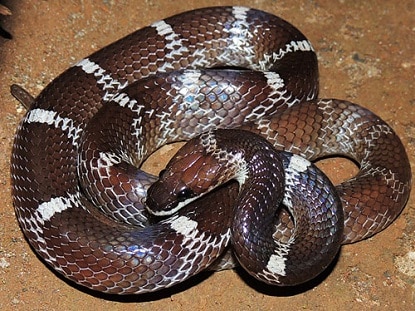
In India, there’s a non-venomous species which nevertheless has a nasty personality, and is notorious for invading human habitations. This species is the Indian wolf snake (Lycodon aulicus) which is ubiquitous across the entire country (except the Himalaya and true deserts), and occupies habitats ranging from arid plains, to leafy villages, to bustling cities such as Agra.
The Indian wolf snake averages at 70-80cm for adult females, and 50-60cm for males. As well as India, they can be found in Sri Lanka, Bangladesh and Myanmar. They’ve been found in countless hideaways within human habitation: on brick piles, poking their heads out of walls, in wardrobes, in toilets, even in old suitcases about to be dusted off for a holiday.
Indian wolf snakes are experts at exploiting flaws in building work, such as cracks in pavements or stone walls. They simply love human dwellings, and are pulled like a tractor beam to the darkness of roofs and ceilings, where they finally come to a rest in the shadows.
Nevertheless, there’s a weird contradiction with this species, as when they actually meet a human, they suffer a virtual panic attack, and instantly hit red alert. One reason Indian wolf snakes invade dwellings so easily is that they slither vertically up walls, which must be fun. With a huge range in southern Asia, this snake likely has a global population well into the tens of millions.
| 2 | Chocolate brown, but many morphs |
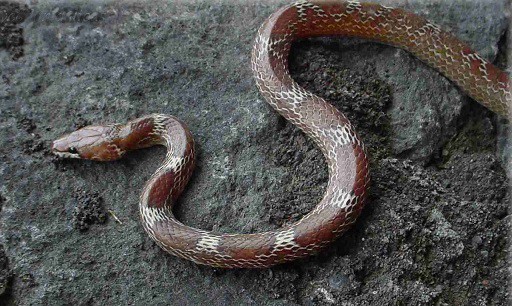
The Indian wolf snake is a smooth snake to touch rather than keeled and spiky. They have a very long, thin tail, which tapers to a point. This is a snake of many morphs, rather than one monolithic colour all over India.
The standard morph is a chocolate brown, overlaid with white stripes that are thin and bending rather than orderly like a coral snake’s. However, the bands can also be a sunflower yellow, or so faint that they’re barely noticeable, like a tiny smattering of pale dirt. In some, the pale sections are snowy white and spread to between the scales. Others are melanistic, an extremely black colour due to higher pigment accumulation. Generally, the white bands are more vivid until year 2 or 3, when they become razor thin.
Indian wolf snakes are particularly weird in that their skull shape varies. Some have a far bulkier head, with a white cap laid on top. Colour variations are common within snake species, but multiple skull shapes are rare. Albino Indian wolf snakes aren’t unheard of either. These have a totally white body colour, with red eyes, with extremely faint blotches still visible on their bodies.
| 3 | Non-venomous, but rips through flesh |
As if a snake attempting to break through your window wasn’t terrifying enough, the Indian wolf snake is a notoriously bad-tempered species. They might not be venomous, but Lycodon aulicus often delivers savage, snapping bites to homeowners and park visitors alike.
A Bangladeshi study found that 55% of bites struck the feet, while 45% landed on the hands. On the surface, the bite looks like a mere scape, which you’d stop noticing within hours, but the razor sharp fangs produce a much deeper wound than appearances suggest. When biting, they open their upper and lower jaws at a 90 degree angle to each other, and tend to hang on and chew after biting.
Wolf snakes are very difficult to keep in captivity, as the bite portion of their brain activates almost without fail when picked up. Only a feather light touch will keep them calm, so that they can barely feel the floor shifting beneath them. There’s no bustling worldwide trade in Lycodon aulicus like with the blood python.
| 4 | Not shy, not calm |
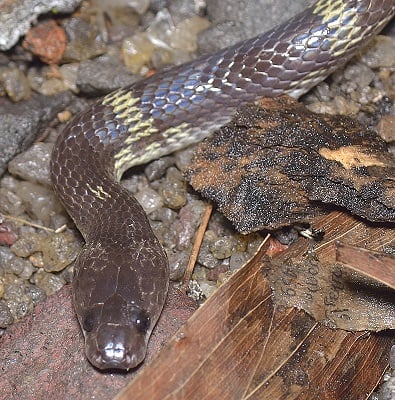
All this leads to a record, where Indian wolf snakes dominate all: it ranks first in Bangladesh for bites from non-venomous snakes. The reason is a particularly irritable personality, combined with their magnetic pull towards human settlements, resulting in a perfect storm of bites.
However, they also hold a second record which makes you feel more sorry for them. A study from the Indian city of Agra found that they were the third most commonly rescued snake from human habitation, ranking second in some years like 2018. The bold, adventurous oriental ratsnake ranked first, followed by the Indian rock python. The study was conducted during the COVID lockdown of 2020. People were stuck at home, and had many more encounters with the local wildlife. Encounters with Lycodon aulicus shot up significantly compared to the previous year, with residents desperately fending off hordes of mindless wolf snakes attempting to slither into their houses.
In Sri Lanka, meanwhile, Lycodon aulicus ranked 2nd for non-venomous snakebites in a 2020 study. In first was the notoriously aggressive trinket snake.
| 5 | Plays dead convincingly |
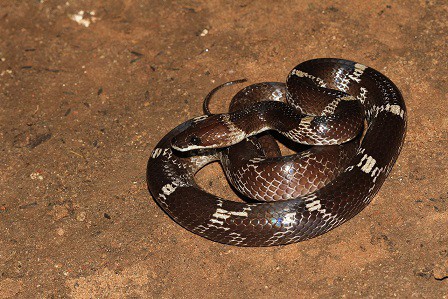
Lycodon aulicus also has a bonus move: the headbutt, where it lunges while keeping its mouth shut and bashes the intruder. The less aggressive ones will coil up until a ball and protect their brains, and they’ll even go floppy and fake death, flipping over to show their bright belly scales. One Lycodon aulicus feigned death so convincingly that the disappointed scientists left the room; when they returned 30 minutes later, it was alive and well.
This snake has virtually every defence move except venom. Like many snakes, they produce a foul snake smell, to force you into eye-watering retreat, but with this species the stench is like rotting dead mice.
Indian wolf snakes play fair and give you a chance, as they produce a warning siren: a buzzing sound achieved by vibrating their tail from side to side. This noise mimics a rattlesnake’s rattle without actually having one. Their next move is either a savage strike, or a quick darting escape, using the few seconds afforded to them by the predator’s hesitant halting.
| 6 | Loves geckos (their taste anyway) |
Indian wolf snakes have a flexible diet, but specialise in reptiles, with members of the Hemidactylus gecko family being a favourite. These include the common house gecko and northern house gecko. Their jagged front teeth evolved to pierce their scales.
Indian wolf snakes have a time tested system for hunting. They firstly bite the gecko by the belly, before wrapping around two firm coils in a complete body loop. Instead of asphyxiating prey like a boa, cutting off blood flow, this is designed to prevent the gecko’s lungs from inflating. The Indian wolf snake then shifts its coil positions and constricts properly, rendering the gecko motionless in approximately 3 minutes. The Indian wolf snake then swallows its prey rapidly. They always swallow by the head, and can wolf a gecko down in as little as 30 seconds. This is one of the fastest swallowers around; the Spanish false smooth snake can take 70 minutes to swallow a lizard.
Lycodon aulicus is also a bat-eating snake, having been spotted with small vesper bats in their clutches.
| 7 | Rapidly hatching eggs |
Indian wolf snakes are extremely sensitive to smell. They’ll follow the scent trail of a common house gecko to the ends of the Earth, and they also flinch savagely when exposed to shoe polish. Males use this power to find females, and you can often find several male Indian wolf snakes on the trail of one female.
Lycodon aulicus is an egg-laying species. They produce 8-16 per clutch, laying 3-5 in three separate batches. These eggs are pale white and far longer than a chicken egg, and have a pliable, sticky substance coating the shell. Mothers coil around their eggs for 2-3 days, and the babies hatch extremely quickly, taking just 7 days to hack free, which they achieve using an egg tooth on their forehead.
The average newborn Lycodon aulicus measures 14-15.5cm, and is able to hunt and feed instantly. Many Indian wolf snakes can flock to the same egg-laying hollow for years. New mothers have been found with their fresh eggs, surrounded by ancient shells. It’s probably their sharp sense of smell, which informs them that previous mothers have been there.
| 8 | Easy to confuse |
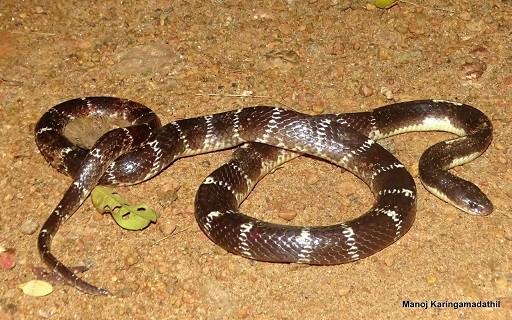
The Bengal krait (Bungarus caeruleus) is one of the big 4 venomous snakes in India, causing over 30% of snake deaths in many regions. Many snakes mimic its colours to gain a shield from birds without lifting a finger, including the common bridal snake and Kelaart’s earth snake. It might have the most mimics of any snake worldwide, and the Indian wolf snake is probably the most successful. The black and white colours are a match, with no bonus red or yellow sprinkled around. But Lycodon aulicus goes a step further, and copies the exact razor-thin width of the bands.
It appears that Bungarus caeruleus isn’t pleased about the wolf snake piggybacking off its venom, as they’ve been photographed eating them in the past. The one predator that isn’t fooled by the mimic is the mimicked itself. In personality, these species are different, as the Bengal krait is slow and sluggish while the Indian wolf snake is alert and curious. But Bungarus caeruleus has the advantage of venom, a neurotoxic mixture that begins its symptoms with a sharp stomach ache.
| 9 | Fang facts |
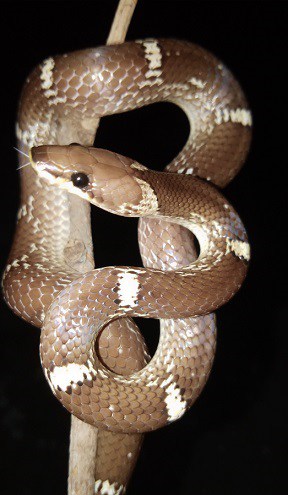
Lycodon aulicus also has an insect which is theorised to be mimicking them: a Burmese moth called Tonica barrowi, which has a wingspan of 7.8cm. The resemblance happens while in its long chrysalis case, the transitional stage to adulthood, after which they break free and fly off. If true, this would scare off bird predators, fearful of the wolf snake’s vicious front fangs.
The Indian wolf snake’s name in Latin is telling, as Lycodon is derived from the Greek words “lykos” for wolf, and “odon” for tooth. It refers to their dentistry, the way their rows of teeth are arranged. Despite being non-venomous, Indian wolf snakes have the sharpest fangs at the front of their jaw, two on each of the lower and upper jaws.
The second from the front is the sharper of the two, the jagged fang that rips people’s flesh. Both sharp fangs curve backwards at an angle of 40 degrees. After a gap, the upper jaw then has 4-12 smaller teeth, with the final tooth being the largest. The goal is to imprison geckos, with longer bars at the front and back.
| 10 | Relatives and genetics |
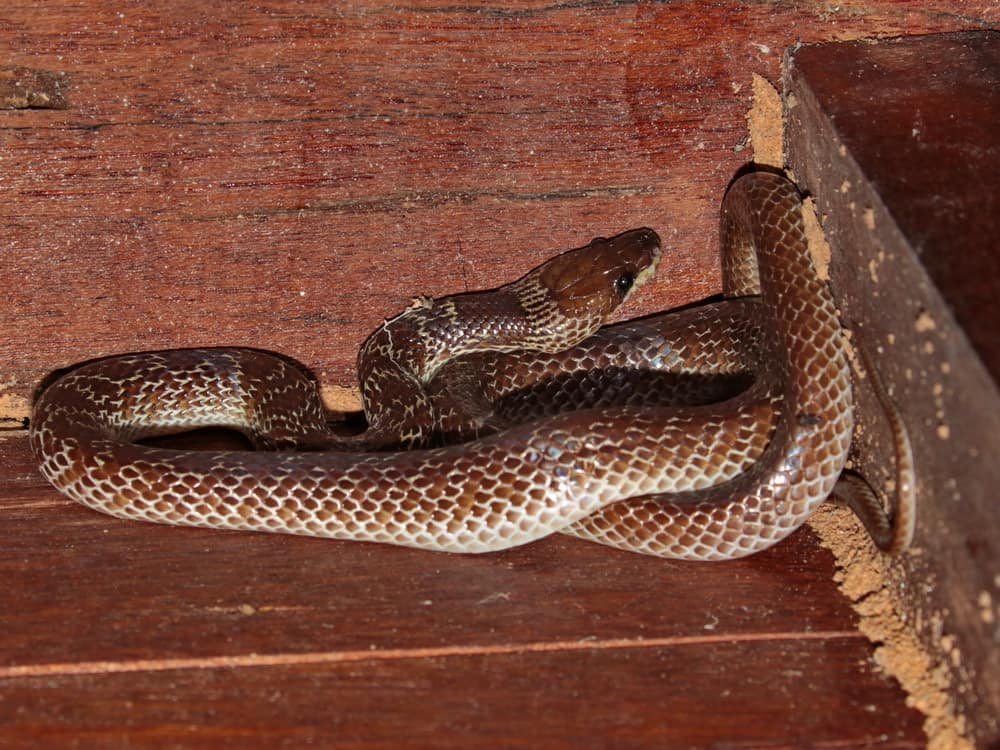
The Lycodon wolf snake family currently has 73 members, the most recent being the Huaping wolf snake (Lycodon cathaya), discovered in China’s Huaping nature reserve in 2020. Thailand has 13 species alone, many found near obscure waterfalls.
Until recently, the Indian wolf snake was believed to cover the vast majority of the Lycodon family’s territory. It was believed to range from Pakistan, through India, and only stopping at Indonesian Papua. It was a sort of master Lycodon member that all the smaller ones were based off. But in 2013, the eastern half of its empire was savagely chopped off. All members beyond southern Burma, including the whole of Thailand, were reassigned to a new species: Lycodon capucinus.
As well as subtle scale counts, this was clearly separated by a lighter base brown colour, sometimes with red tinges. In the Indian wolf snake, the white patterns are usually separated into individual bands, while in Lycodon capucinus, they’re more of a net-shaped giraffe pattern. This southeast Asian version is either called the common wolf snake or oriental wolf snake.
These days, the Indian wolf snake’s realms include Nepal, Bhutan, Burma, Pakistan, Bangladesh and Sri Lanka. They’re also an invasive species on the Mascarene islands of Réunion and Mauritius, off the east coast of Madagascar, where they’ve decimated the local lizards.
